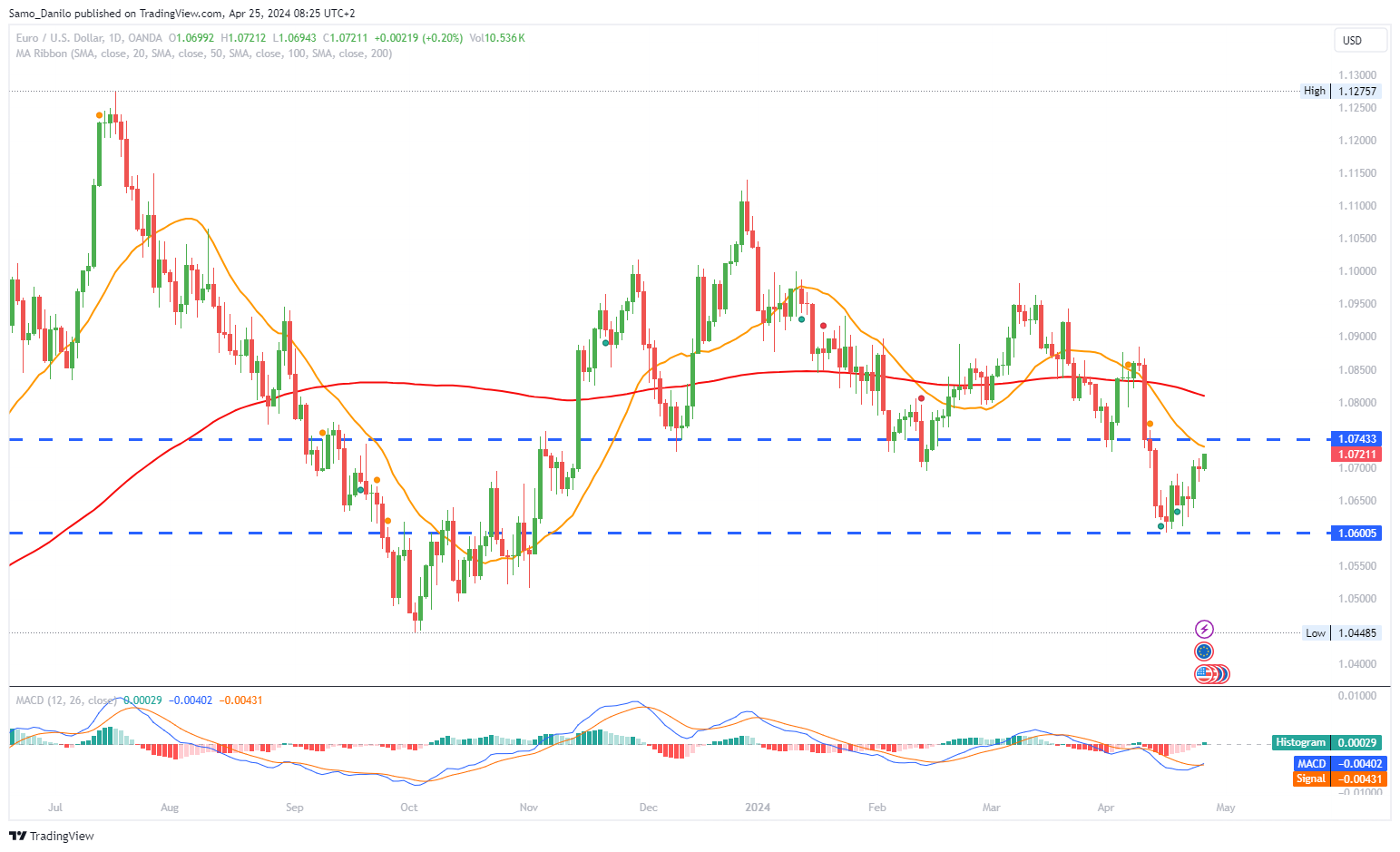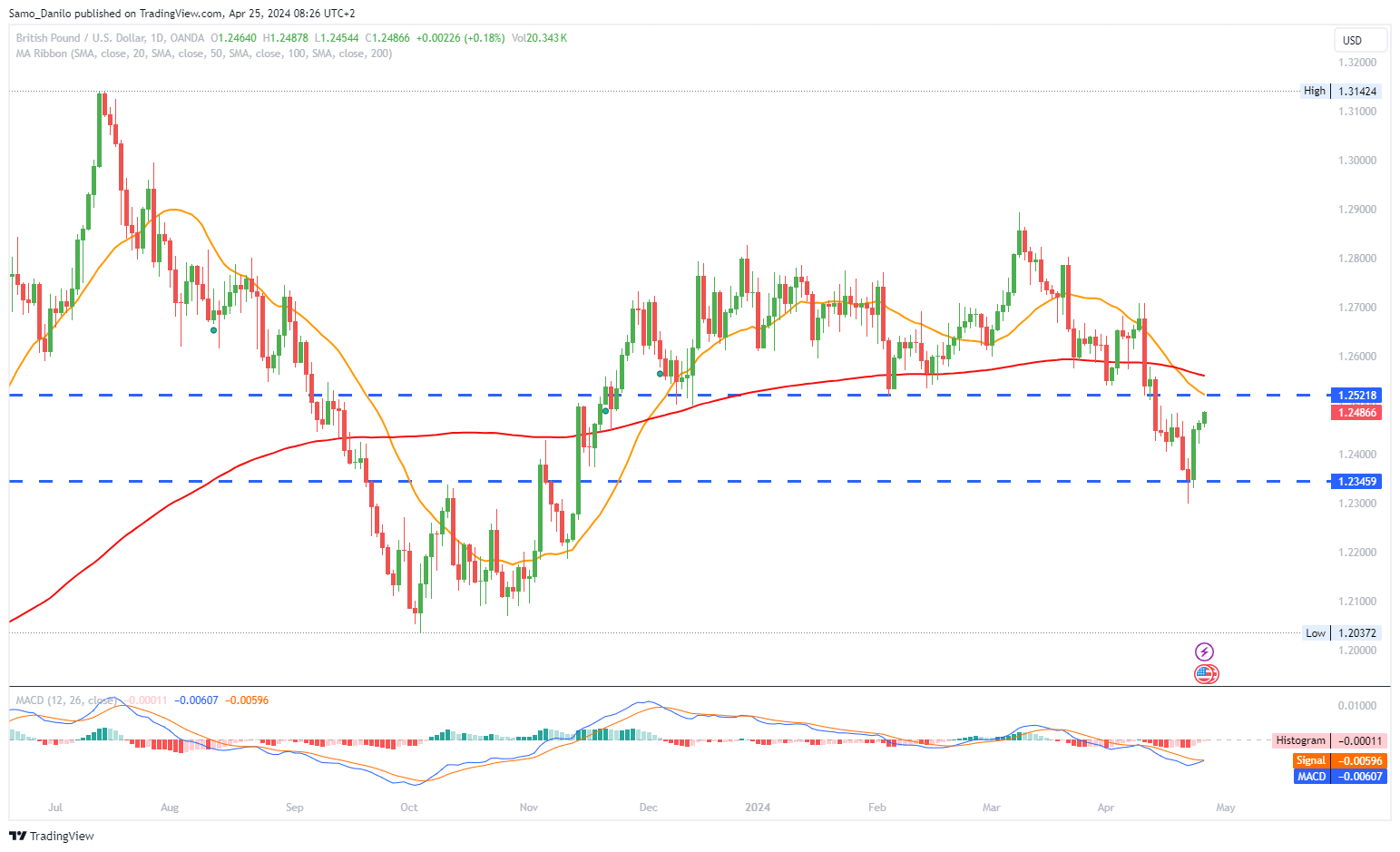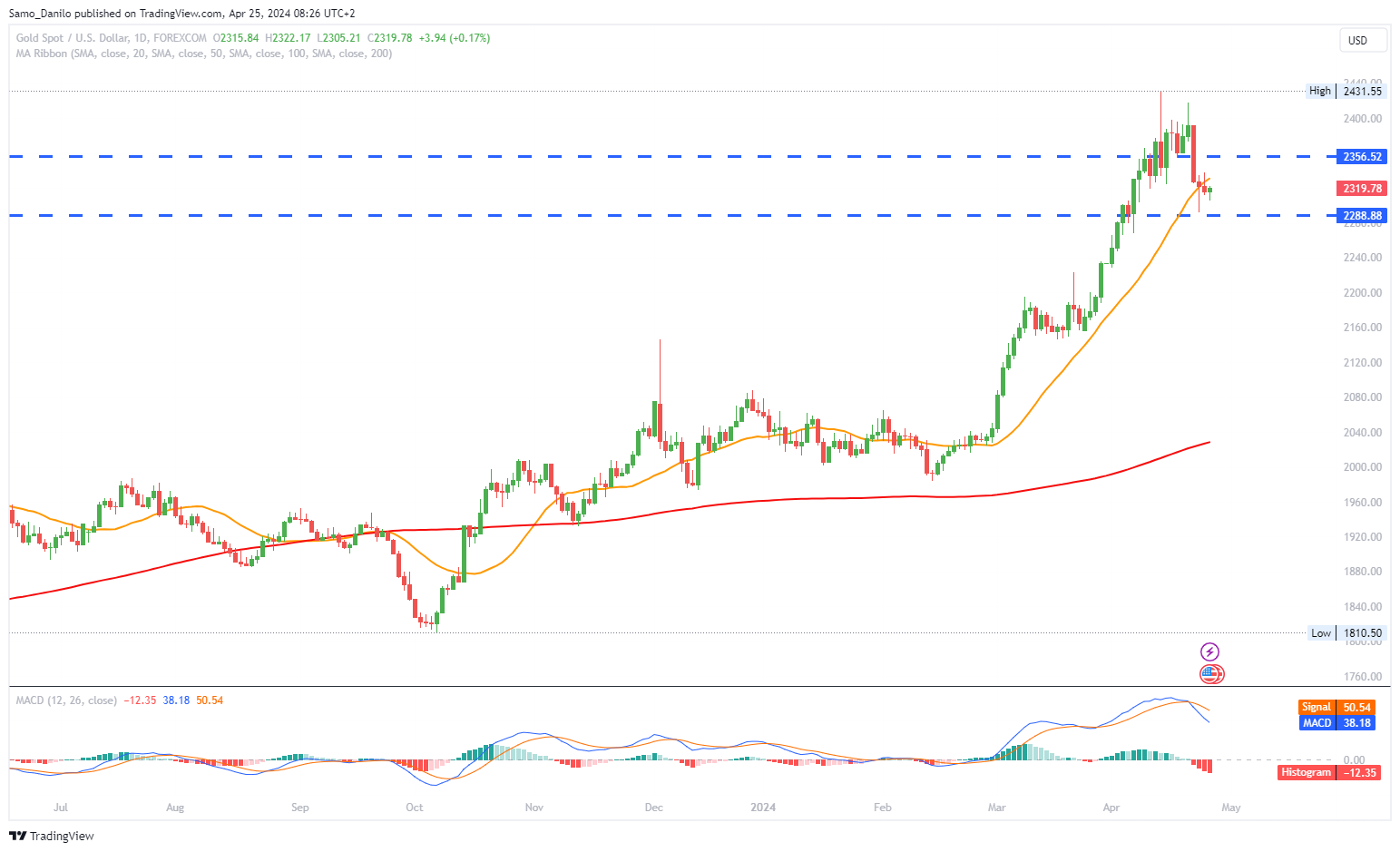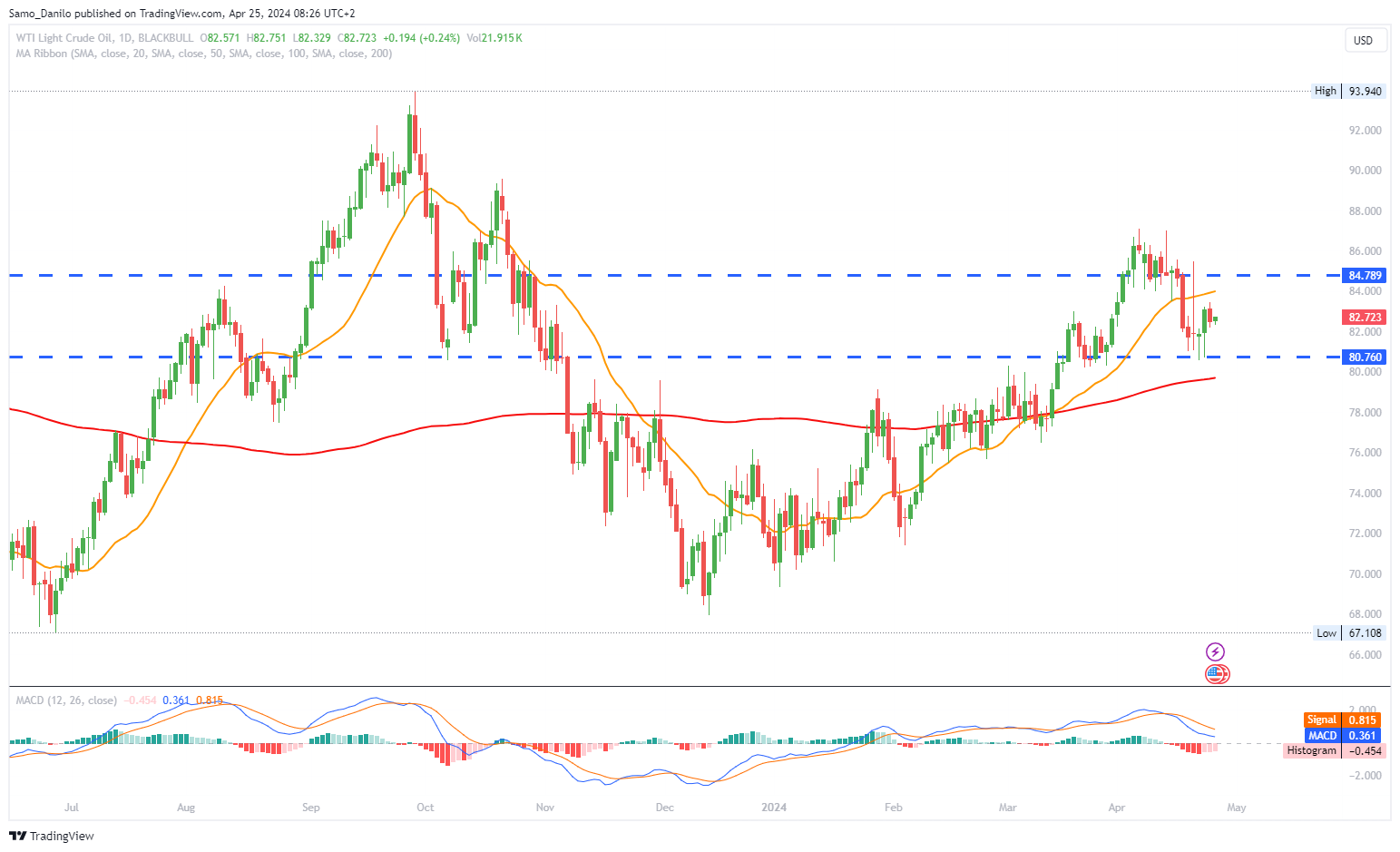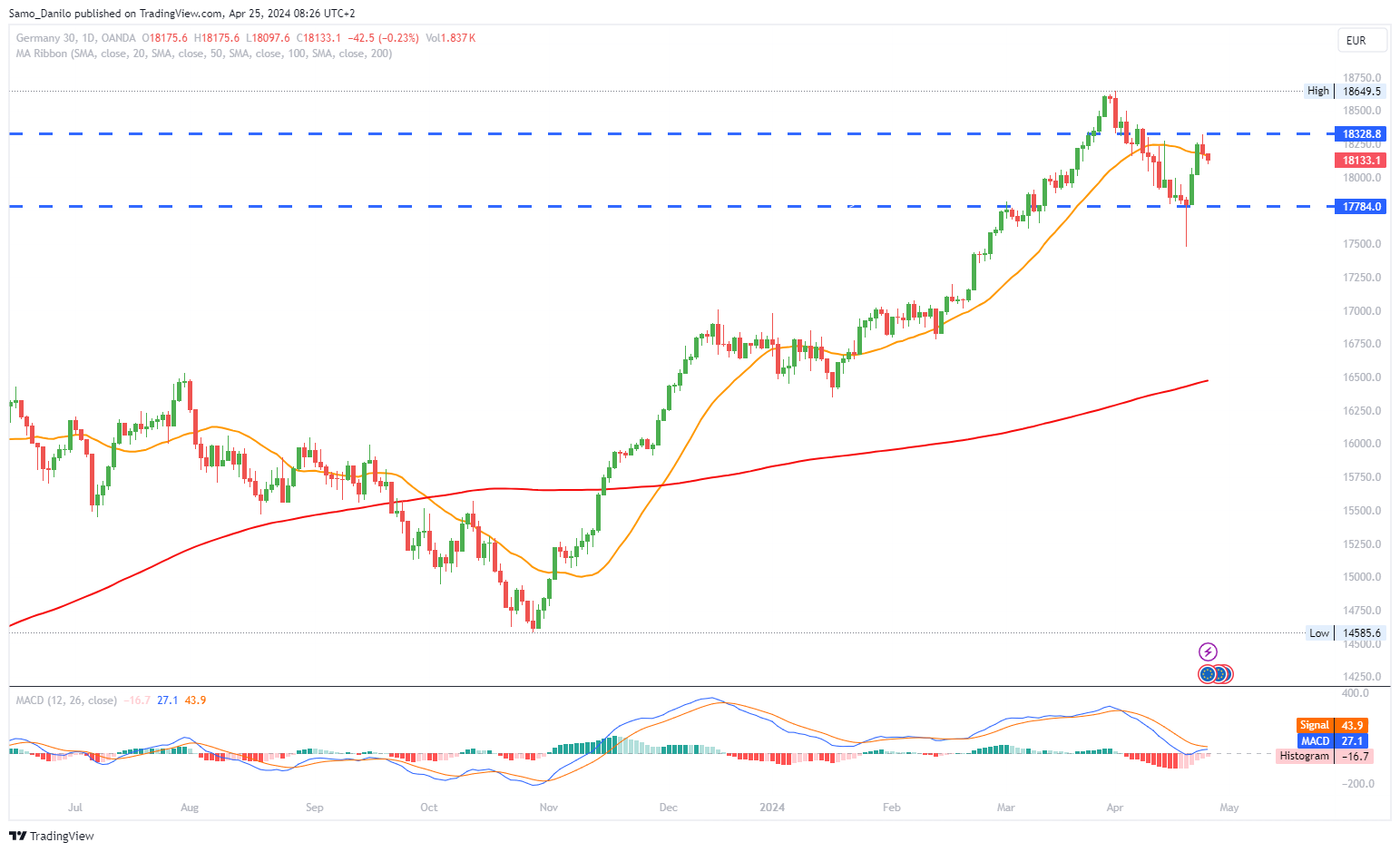EURUSD
- EUR/USD maintains its position above the 1.0700 level early on Thursday in European trading, indicating resilience in the euro against the US dollar.
- Wednesday's data from the US Department of Commerce showed that Durable Goods Orders in the United States rose by 2.6% month-on-month in March, surpassing expectations and potentially influencing market sentiment toward the US dollar.
- Investors are eagerly awaiting the release of US GDP data for the first quarter, which will provide insights into the strength of the US economy and could impact the Federal Reserve's future monetary policy decisions.
- Despite the persistence of elevated US inflation, European Central Bank (ECB) policymakers remain committed to their plans for interest rate cuts this year, contrasting with the potential delay in the Federal Reserve's policy adjustment.
- ECB President Christine Lagarde has hinted at the possibility of a deposit rate cut in June, signaling the central bank's readiness to take further action to support the eurozone economy.
Closing statement: EUR/USD remains resilient above the 1.0700 level, supported by cautious optimism in the eurozone economy. Market focus shifts to US GDP data for insights into the strength of the US economy and its implications for the Federal Reserve's monetary policy stance. Meanwhile, ECB policymakers maintain their commitment to potential interest rate cuts, with further actions expected to be considered in the coming months.
GBPUSD
- GBP/USD consolidates its recent recovery from the year-to-date low around the 1.2300 level, exhibiting stability during the Asian trading session on Thursday.
- Technical indicators on the daily chart suggest a negative bias, indicating potential resistance levels that could limit further upside movement in the GBP/USD pair.
- The US dollar receives support from expectations that the Federal Reserve will postpone interest rate cuts due to persistent inflationary pressures, contributing to headwinds for the GBP/USD pair.
- Speculation regarding more aggressive policy easing by the Bank of England undermines demand for the British pound, adding downward pressure on the GBP/USD pair.
- Market attention remains focused on key US macroeconomic data releases, including the Advance Q1 GDP report and the Personal Consumption Expenditures (PCE) Price Index, which could influence the direction of the GBP/USD pair in the near term.
| SMA (20) | Falling |
|
|
| RSI (14) | Rising |
|
|
| MACD (12, 26, 9) | Falling |
|
|
Closing statement: GBP/USD maintains its recovery momentum but faces resistance amid technical indicators signalling a negative bias. Support for the US dollar from expectations of delayed Fed rate cuts and speculation about aggressive BoE policy easing weigh on the pair. Attention shifts to upcoming US macroeconomic data releases for further guidance on GBP/USD movements.
GOLD
- Gold stabilizes as broad risk aversion prompts investors to avoid taking significant positions ahead of the preliminary reading of the US first-quarter GDP, scheduled for Thursday. From a technical standpoint, gold price remains below the key 21-day Simple Moving Average (SMA), indicating continued bearish sentiment among traders.
- Investor risk aversion is further fueled by concerns about potential intervention in the Japanese forex market, with the USD/JPY pair reaching fresh 34-year highs near 155.50.
- Weak S&P Global US business PMI data raise doubts about the economic outlook in the United States, contributing to expectations that the Federal Reserve may maintain higher interest rates for an extended period.
- Additionally, data from the UK's Office for National Statistics (ONS) reveal a significant decline in shipping traffic through the Suez Canal due to Iran-backed Houthi attacks, heightening inflation risks and further supporting demand for gold as a safe-haven asset.
| SMA (20) | Rising |
|
|
| RSI (14) | Falling |
|
|
| MACD (12, 26, 9) | Falling |
|
|
Closing statement: Gold maintains stability amid broad risk aversion as investors await the US first-quarter GDP reading. Technical indicators suggest continued bearish sentiment, while concerns about intervention in the Japanese forex market and weak US economic data bolster demand for the safe-haven metal. Heightened inflation risks stemming from geopolitical tensions add further support to gold prices.
CRUDE OIL
- WTI crude oil trades in a range around $82.90 on Thursday as market participants assess geopolitical tensions and supply dynamics.
- Recent perceived de-escalation between Iran and Israel, along with uninterrupted oil flow from the Middle East, has contributed to lower WTI prices in recent sessions. However, the potential for rising tensions in the Middle East and the possibility of stricter sanctions against Iran could limit the downside for WTI prices.
- Speculation that the US Federal Reserve may delay interest rate hikes provides support to the dollar but acts as a headwind for oil prices.
- Additionally, US commercial crude stockpiles for the week ending April 19 experienced a significant drawdown of 6.368 million barrels, the largest since mid-January, which may support oil prices amid supply concerns.
| SMA (20) | Rising |
|
|
| RSI (14) | Neutral | ||
| MACD (12, 26, 9) | Falling |
|
|
Closing statement: WTI crude oil hovers around $82.90 amid mixed factors including geopolitical tensions, supply dynamics, and speculation about US Federal Reserve policy. Despite recent de-escalation signals in the Middle East, concerns about potential supply disruptions and a significant drawdown in US crude inventories provide some support to oil prices. However, the prospect of delayed interest rate hikes by the Fed and a stronger dollar may continue to weigh on crude oil in the near term.
DAX
- The Ifo Business Climate Index for Germany rose from 87.9 to 89.4 in April, signaling ongoing improvement in the macroeconomic environment.
- Despite positive economic indicators, comments from ECB officials impacted buyer demand for DAX-listed stocks. Bundesbank President Joachim Nagel suggested that a series of interest rate cuts might not be likely even if data supported a June rate cut.
- The forward-looking consumer-climate index for Germany, published by research group GfK and the Nuremberg Institute for Market Decisions, forecasts an increase in confidence to minus 24.2 in May, the highest level since May 2022.
- Investors should monitor ECB commentary and reports, with ECB Executive Board member Isabel Schnabel scheduled to speak. Additionally, the ECB Economic Bulletin will draw investor interest.
- In addition to economic indicators, corporate earnings reports will be closely watched. Companies such as STMicroelectronics, Schneider Electric, Merck & Co, Hermes International, Deutsche Bank, Delivery Hero, BNP Paribas, BASF, and Airbus are among the major names set to release earnings results.
| SMA (20) | Slightly Rising |
| |
| RSI (14) | Rising |
|
|
| MACD (12, 26, 9) | Falling |
|
|
Closing statement: Despite positive signs of economic recovery in Germany, comments from ECB officials regarding interest rate cuts influenced buyer demand for DAX-listed stocks. While economic indicators continue to signal improvement, investors remain cautious and await further guidance from central bank officials. In addition to economic data, corporate earnings reports from key companies will provide further insights into the market sentiment and outlook for DAX-listed stocks.
